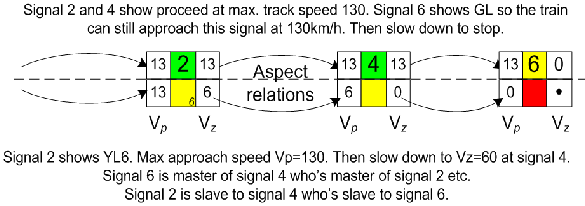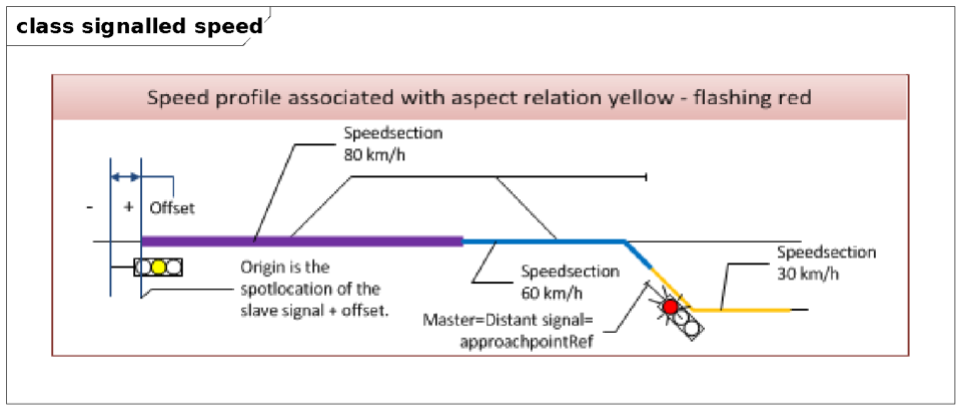Introduction
Documentation
Syntax
|
|
| Documentation
|
The references to the signal plans the interlocking uses
|
| Subschema
|
interlocking
|
| Parents*
|
signalBox
|
| Children
|
aspectRelation (1..*)
|
Attributes:
None
|
*Notice:
Elements may have different parent elements. As a consequence they may be used in different contexts.
Please, consider this as well as a user of this wiki as when developing this documentation further.
Aspects that are only relevant with respect to one of several parents should be explained exclusively in the documentation of the respective parent element.
|
|
|
| Documentation
|
The references to the signal plans the interlocking uses
|
| Subschema
|
interlocking
|
| Parents*
|
signalBox
|
| Children
|
any (0..*), aspectRelation (1..*), designator (0..1)
|
Attributes:
- id: unique identifier (optional;
xs:ID; patterns: (urn:uuid:)?[0-9a-fA-F]{8}-[0-9a-fA-F]{4}-[0-9a-fA-F]{4}-[0-9a-fA-F]{4}-[0-9a-fA-F]{12}|{[0-9a-fA-F]{8}-[0-9a-fA-F]{4}-[0-9a-fA-F]{4}-[0-9a-fA-F]{4}-[0-9a-fA-F]{12}}); compare: Dev:Identities
|
*Notice:
Elements may have different parent elements. As a consequence they may be used in different contexts.
Please, consider this as well as a user of this wiki as when developing this documentation further.
Aspects that are only relevant with respect to one of several parents should be explained exclusively in the documentation of the respective parent element.
|
Changes 3.1→3.2
The children have changed.
The attributes have been changed.
Semantics
Best Practice / Examples
Signals protect the path as defined in <knowsRoute>. Depending on the particular signalling system used there is not a strict 1:1 relation between the signal aspect and the route as the aspect at the route entry may depend on the aspect of the next signal. Therefore the so-called signal plan is used with element <implementsSignalplan> as part of the interlocking features in <signalBox>. It consists of a set of aspect relations whereas the master is always the signal influencing the other. In case of signalling for the route itself, the master is the destination signal of the route and the slave is the start signal of the route. In case of signalling with stand-alone distant signals there is no master and the slave is the start signal of the route. However, with railML3.1 there can be currently no relation described between any main signal and distant signal or repeater.
Each aspect relation consists of:
- @expectingSpeed – This is the maximum signalled speed in km/h at master signal at route exit (aka target speed).
- @passingSpeed – This is the speed in km/h signalled by the slave aspect, i.e. it is the speed that the train must respect when passing the slave signal at route entry.
- @endSectionTime – The end-section of a route is the section between the closed route exit signal and the previous slave signal. Commonly, the interlocking revokes (part of) the route when this timer expires.
- <masterAspect> – This is the status of the master signal (at route exit), i.e. the tuple of signal and aspects the signal is showing.
- <slaveAspect> – This is the status of the slave signal (at route entry) , i.e. the tuple of signal and aspects the signal is showing.
- <distantAspect> – This is the status of the distant signal (within the route or its entry) related to the signal with the <masterAspect>, i.e. the tuple of signal and aspects the signal is showing. This element shall be used for “old-style” signalling systems with separate distant signals or in case of repeaters within the route.
- <signalsSpeedProfile> – This is the reference to a <speedSection> in the infrastructure in case there are sections of the route with speed targets deviating from the signalled speed. The particular speed value and the section position can be derived from the infrastructure element.
- <appliesToRoute> – This is the reference to the route this aspect relation applies to. With knowledge of the route path the signals at route entry and exit can be identified.
Here are some illustrations for aspect relations and signalled speed.

The diagram below depicts the situation as described in the above signal plan example for the lower relation. In order to allow discussion of differences the signal aspect relations are shown for the typical variants of signalling systems, i.e. combined signalling (a), distant signal at the same mast (b) and stand-alone distant signal (c). The used colours and appearance of the signals in diagram are just symbolic and does not reflect a particular system.

The extract shows the railML representation of the above signal plan illustration for both relations. Although the physical appearance of the signal aspects according to the above variants a)...c) are different, the railML representation would only differ in the related aspect, if not considering the separate distant signals. The aspect of distant signals may not to be included here if the relation to the main signal is fix.
<implementsSignalplan id="sipaIL">
<designator register="_SimpleRegister" entry="signalplan illustration"/>
<aspectRelation expectingSpeed="130.0" passingSpeed="130.0" endSectionTime="PT30S" id="sip01">
<designator register="_SimpleRegister" entry="aspects 2-4 upper"/>
<masterAspect>
<refersToSignal ref="sig4"/>
<showsAspect ref="sig_fullproceed"/>
</masterAspect>
<slaveAspect>
<refersToSignal ref="sig2"/>
<showsAspect ref="sig_fullproceed"/>
</slaveAspect>
<appliesToRoute ref="rt_sig02_sig04"/>
</aspectRelation>
<aspectRelation expectingSpeed="60.0" passingSpeed="130.0" endSectionTime="PT30S" id="sip02">
<designator register="_SimpleRegister" entry="aspects 4-6 upper"/>
<masterAspect>
<refersToSignal ref="sig6"/>
<showsAspect ref="sig_YL6"/>
</masterAspect>
<slaveAspect>
<refersToSignal ref="sig4"/>
<showsAspect ref="sig_fullproceed"/>
</slaveAspect>
<appliesToRoute ref="rt_sig04_sig06"/>
</aspectRelation>
<aspectRelation expectingSpeed="60.0" passingSpeed="130.0" endSectionTime="PT30S" id="sip03">
<designator register="_SimpleRegister" entry="aspects 2-4 lower"/>
<masterAspect>
<refersToSignal ref="sig4"/>
<showsAspect ref="sig_YL6"/>
</masterAspect>
<slaveAspect>
<refersToSignal ref="sig2"/>
<showsAspect ref="sig_GL"/>
</slaveAspect>
<appliesToRoute ref="rt_sig02_sig04"/>
</aspectRelation>
<aspectRelation expectingSpeed="0.0" passingSpeed="60.0" endSectionTime="PT30S" id="sip04">
<designator register="_SimpleRegister" entry="aspects 4-6 lower"/>
<masterAspect>
<refersToSignal ref="sig6"/>
<showsAspect ref="sig_Stop"/>
</masterAspect>
<slaveAspect>
<refersToSignal ref="sig4"/>
<showsAspect ref="sig_YL6"/>
</slaveAspect>
<appliesToRoute ref="rt_sig04_sig06"/>
</aspectRelation>
</implementsSignalplan>
The following example shows the variations to reflecting the distant signals in the variants b)...c) from the above picture but using the aspects as defined in the simple example for variants b)...c). The differences between variant b) and c) would be in the location of the referred distant signals only.
Variant a)
<implementsSignalplan id="sipaIL_a">
<designator register="_SimpleRegister" entry="signalplan illustration variant a)"/>
<aspectRelation expectingSpeed="60.0" passingSpeed="130.0" endSectionTime="PT30S" id="sip03">
<designator register="_SimpleRegister" entry="aspects 2-4 variant a)"/>
<masterAspect>
<refersToSignal ref="sig4"/>
<showsAspect ref="sig_YL6"/>
</masterAspect>
<slaveAspect>
<refersToSignal ref="sig2"/>
<showsAspect ref="sig_GL"/>
</slaveAspect>
<appliesToRoute ref="rt_sig02_sig04"/>
</aspectRelation>
<aspectRelation expectingSpeed="0.0" passingSpeed="60.0" endSectionTime="PT30S" id="sip04">
<designator register="_SimpleRegister" entry="aspects 4-6 variant a)"/>
<masterAspect>
<refersToSignal ref="sig6"/>
<showsAspect ref="sig_Stop"/>
</masterAspect>
<slaveAspect>
<refersToSignal ref="sig4"/>
<showsAspect ref="sig_YL6"/>
</slaveAspect>
<appliesToRoute ref="rt_sig04_sig06"/>
</aspectRelation>
</implementsSignalplan>
Variants b)…c) differ only by the position of the distant signals in the infrastructure.
<implementsSignalplan id="sipaIL_b-c">
<designator register="_SimpleRegister" entry="signalplan illustration variant b)"/>
<aspectRelation expectingSpeed="60.0" passingSpeed="130.0" endSectionTime="PT30S" id="sip03">
<designator register="_SimpleRegister" entry="aspects 2-4 variant b)"/>
<masterAspect>
<refersToSignal ref="sig4"/>
<showsAspect ref="sig_reducproceed_21"/>
</masterAspect>
<slaveAspect>
<refersToSignal ref="sig2"/>
<showsAspect ref="sig_fullproceed_22"/>
</slaveAspect>
<distantAspect>
<refersToSignal ref="dsig4"/>
<showsAspect ref="sig_warning_25"/>
</distantAspect>
<appliesToRoute ref="rt_sig02_sig04"/>
</aspectRelation>
<aspectRelation expectingSpeed="0.0" passingSpeed="60.0" endSectionTime="PT30S" id="sip04">
<designator register="_SimpleRegister" entry="aspects 4-6 variant a)"/>
<masterAspect>
<refersToSignal ref="sig6"/>
<showsAspect ref="sig_closed_20"/>
</masterAspect>
<slaveAspect>
<refersToSignal ref="sig4"/>
<showsAspect ref="sig_reducproceed_21"/>
</slaveAspect>
<distantAspect>
<refersToSignal ref="dsig6"/>
<showsAspect ref="sig_caution_23"/>
</distantAspect>
<appliesToRoute ref="rt_sig04_sig06"/>
</aspectRelation>
</implementsSignalplan>
The following example shows the combination of signal aspects with additional speed and direction indicators. There are two relations shown in the picture below:
- Sig1 (reduced, “8”, “L”) → Sig2 (reduced, “5”, “L”) → Sig6 (proceed)
- Sig3 (reduced, “6”, “N”) → Sig4 (proceed)

<implementsSignalplan id="sipaILc">
<designator register="_SimpleRegister" entry="signalplan sample combination"/>
<aspectRelation expectingSpeed="50.0" passingSpeed="80.0" endSectionTime="PT30S" id="sip12">
<designator register="_SimpleRegister" entry="aspects 1-2"/>
<masterAspect>
<refersToSignal ref="sig2"/>
<showsAspect ref="sig_reducproceed_21"/>
<showsAspect ref="isp50"/>
<showsAspect ref="idirL"/>
</masterAspect>
<slaveAspect>
<refersToSignal ref="sig1"/>
<showsAspect ref="sig_reducproceed_21"/>
<showsAspect ref="isp80"/>
<showsAspect ref="idirL"/>
</slaveAspect>
<signalsSpeedProfile ref="sps01"/>
<appliesToRoute ref="rt_sig1_sig2"/>
</aspectRelation>
<aspectRelation expectingSpeed="120.0" passingSpeed="50.0" endSectionTime="PT30S" id="sip26">
<designator register="_SimpleRegister" entry="aspects 2-6"/>
<masterAspect>
<refersToSignal ref="sig6"/>
<showsAspect ref="sig_fullproceed_22"/>
</masterAspect>
<slaveAspect>
<refersToSignal ref="sig2"/>
<showsAspect ref="sig_reducproceed_21"/>
<showsAspect ref="isp50"/>
<showsAspect ref="idirL"/>
</slaveAspect>
<signalsSpeedProfile ref="sps02"/>
<appliesToRoute ref="rt_sig2_sig6"/>
</aspectRelation>
<aspectRelation expectingSpeed="160.0" passingSpeed="60.0" endSectionTime="PT30S" id="sip34">
<designator register="_SimpleRegister" entry="aspects 3-4"/>
<masterAspect>
<refersToSignal ref="sig4"/>
<showsAspect ref="sig_fullproceed_22"/>
</masterAspect>
<slaveAspect>
<refersToSignal ref="sig3"/>
<showsAspect ref="sig_reducproceed_21"/>
<showsAspect ref="isp60"/>
<showsAspect ref="idirN"/>
</slaveAspect>
<signalsSpeedProfile ref="sps03"/>
<appliesToRoute ref="rt_sig3_sig4"/>
</aspectRelation>
</implementsSignalplan>
……
<hasAspect id="sig_reducproceed_21" genericAspect="LimitedProceed" >
<designator register="_SimpleRegister" entry="Signal 21 «Kjør med redusert hastighet»"/>
</hasAspect>
<hasAspect id="isp80" genericAspect="Informative" >
<designator register="_SimpleRegister" entry="speed80"/>
</hasAspect>
<hasAspect id="isp60" genericAspect="Informative" >
<designator register="_SimpleRegister" entry="speed60"/>
</hasAspect>
<hasAspect id="isp50" genericAspect="Informative" >
<designator register="_SimpleRegister" entry="speed50"/>
</hasAspect>
<hasAspect id="idirL" genericAspect="Informative" >
<designator register="_SimpleRegister" entry="directionL"/>
</hasAspect>
<hasAspect id="idirN" genericAspect="Informative" >
<designator register="_SimpleRegister" entry="directionN"/>
</hasAspect>
There are cases when the signalled speed is not applicable for the entire length of the route. Typical situation is that there are diverging switches on one part of the way like in exit routes. Depending on the signalling system this additional information can be communicated to the train and its driver. Then the interlocking shall be aware of the situation in order to trigger the information transfer.

The extract shows the aspect relations for both exit routes from station Arnau (ARN) on to the open line towards main signal 69A. According the speed restrictions on switch 68W02 the signalled speed for the diverging route is 60 km/h. For both start signals the speed to expect is set to 0 km/h that is related to the slave aspect (expect to stop) of distant signal 69Va. These values are included here merely for illustration. From the configuration in the simple example the destination signal 69A has a stand-alone distant signal 69Va. Thus no relation to master aspect is really shown at either start signal 68N1 and 68N2. The use of <masterAspect> and @expectingSpeed is limited to cases of real aspect relations between destination and start signal.
<implementsSignalplan id="sipaAC">
<designator register="_SimpleRegister" entry="signalplan ARN-CST"/>
<aspectRelation expectingSpeed="0.0" passingSpeed="60.0" endSectionTime="PT30S" id="sip01">
<designator register="_SimpleRegister" entry="aspects 68N1-69A"/>
<masterAspect>
<refersToSignal ref="ls_sig04"/>
<showsAspect ref="sig_caution_23"/>
</masterAspect>
<slaveAspect>
<refersToSignal ref="mb_sig02"/>
<showsAspect ref="sig_reducproceed_21"/>
</slaveAspect>
<signalsSpeedProfile ref="sps01"/>
<appliesToRoute ref="rt_sig02_sig04"/>
</aspectRelation>
<aspectRelation expectingSpeed="0.0" passingSpeed="80.0" endSectionTime="PT30S" id="sip02">
<designator register="_SimpleRegister" entry="aspects 68N2-69A"/>
<masterAspect>
<refersToSignal ref="ls_sig04"/>
<showsAspect ref="sig_caution_23"/>
</masterAspect>
<slaveAspect>
<refersToSignal ref="mb_sig01"/>
<showsAspect ref="sig_fullproceed_22"/>
</slaveAspect>
<signalsSpeedProfile ref="sps01"/>
<appliesToRoute ref="rt_sig01_sig04"/>
</aspectRelation>
</implementsSignalplan>
Additional Information
Notes
Open Issues



